Adaptive Dynamic Event-Triggered Sliding Mode Tracking Control of Pneumatic Vibration Isolation System
Abstract
1. Introduction
- A pneumatic vibration isolation platform is designed and constructed, and the corresponding dynamic model is established, where the model considers the unknown threshold voltage at the input side.
- An adaptive dynamic event-triggered sliding mode tracking control strategy is proposed, wherein a novel dynamic event-triggered mechanism is constructed accompanied by a rigorous Lyapunov-based stability proof, which also guarantees the exclusion of Zeno behavior. Unlike existing methods, the designed controller provides adaptive compensation for the unknown threshold voltage. Moreover, the introduced dynamic event-triggered mechanism effectively suppresses unnecessary actuator switching, thereby improving energy efficiency and extending actuator lifespan.
- Experimental results verify the effectiveness and superiority of the proposed approach, showing a significant reduction in control updates compared with conventional time-triggered methods.
2. Experimental Setup and Dynamic Modeling
2.1. Experimental Setup
2.2. Pneumatic System Modeling
2.3. Tracking-Error System
3. Design of Controllers
3.1. Time-Triggered Adaptive Sliding Mode Controller
3.2. Dynamic Event-Triggered Sliding Mode Control
3.3. Exclusion of Zeno Behavior
4. Experiments
5. Conclusions
Author Contributions
Funding
Institutional Review Board Statement
Informed Consent Statement
Data Availability Statement
Conflicts of Interest
References
- Bergerman, M.; Van Henten, E.; Billingsley, J.; Reid, J.; Deng, M. IEEE robotics and automation society technical committee on agricultural robotics and automation. IEEE Robot. Autom. Mag. 2013, 20, 20–23. [Google Scholar] [CrossRef]
- Kato, T.; Kawashima, K.; Sawamoto, K.; Kagawa, T. Active control of a pneumatic isolation table using model following control and a pressure differentiator. Precis. Eng. 2007, 31, 269–275. [Google Scholar] [CrossRef]
- Shirani, H.; Wakui, S. Control of an isolated table’s fluctuation caused by supplied air pressure using a voice coil motor. J. Syst. Des. Dyn. 2010, 4, 406–415. [Google Scholar] [CrossRef]
- Xu, S.; Liu, X.; Wang, Y.; Sun, Z.; Wu, J.; Shi, Y. Frequency shaping-based H∞ control for active pneumatic vibration isolation with input voltage saturation. Mech. Syst. Signal Process. 2024, 220, 111705. [Google Scholar] [CrossRef]
- Deng, M.; Inoue, A.; Yanou, A.; Hirashima, Y. Continuous-time anti-windup generalized predictive control of non-minimum phase processes with input constraints. In Proceedings of the 42nd IEEE International Conference on Decision and Control, Maui, HI, USA, 9–12 December 2003; Volume 5, pp. 4457–4462. [Google Scholar]
- Katsurayama, Y.; Deng, M.; Jiang, C. Operator-based experimental studies on nonlinear vibration control for an aircraft vertical tail with considering low-order modes. Trans. Inst. Meas. Control 2015, 38, 1421–1433. [Google Scholar] [CrossRef]
- Man, Z.; Mike, O.; Xinghuo, Y. A robust adaptive terminal sliding mode control for rigid robotic manipulators. J. Intell. Robot. Syst. 1999, 24, 23–41. [Google Scholar] [CrossRef]
- Yu, S.; Yu, X.; Shirinzadeh, B.; Man, Z. Continuous finite-time control for robotic manipulators with terminal sliding mode. Automatica 2005, 41, 1957–1964. [Google Scholar] [CrossRef]
- Gao, X.; Deng, M. Operator-based robust nonlinear control of an uncertain wireless power transfer system using sliding mode technology. Trans. Inst. Meas. Control 2018, 40, 4397–4406. [Google Scholar] [CrossRef]
- Rsetam, K.; Cao, Z.; Man, Z. Design of robust terminal sliding mode control for underactuated flexible joint robot. IEEE Trans. Syst. Man Cybern. Syst. 2021, 52, 4272–4285. [Google Scholar] [CrossRef]
- Nasiri, M.; Mobayen, S.; Arzani, A. PID-type terminal sliding mode control for permanent magnet synchronous generator-based enhanced wind energy conversion systems. CSEE J. Power Energy Syst. 2022, 8, 993–1003. [Google Scholar]
- Bu, N.; Zhang, Y.; Zhang, Y.; Morohoshi, Y.; Deng, M. Robust control for hysteretic microhand actuator using robust right coprime factorization. IEEE Trans. Autom. Control 2024, 69, 3982–3988. [Google Scholar] [CrossRef]
- Tian, C.; Liang, H. Fixed-time adaptive event-triggered control for multiagent systems with full-state constraints. Int. J. Syst. Sci. 2024, 55, 1393–1409. [Google Scholar] [CrossRef]
- Chen, M.; Chen, S.; Wu, Q. Sliding mode disturbance observer-based adaptive control for uncertain MIMO nonlinear systems with dead-zone. Int. J. Adapt. Control Signal Process. 2017, 31, 1003–1018. [Google Scholar] [CrossRef]
- Yao, X.; Park, J.H.; Dong, H.; Guo, L.; Lin, X. Robust adaptive nonsingular terminal sliding mode control for automatic train operation. IEEE Trans. Syst. Man Cybern. Syst. 2018, 49, 2406–2415. [Google Scholar] [CrossRef]
- Ghadiri, H.; Emami, M.; Khodadadi, H. Adaptive super-twisting non-singular terminal sliding mode control for tracking of quadrotor with bounded disturbances. Aerosp. Sci. Technol. 2021, 112, 106616. [Google Scholar] [CrossRef]
- Vamvoudakis, K.G. Event-triggered optimal adaptive control algorithm for continuous-time nonlinear systems. IEEE/CAA J. Autom. Sin. 2014, 1, 282–293. [Google Scholar] [CrossRef]
- Shi, X.N.; Zhou, Z.G.; Zhou, D.; Li, R. Event-triggered fixed-time adaptive trajectory tracking for a class of uncertain nonlinear systems with input saturation. IEEE Trans. Circuits Syst. II Express Briefs 2021, 68, 983–987. [Google Scholar] [CrossRef]
- Xing, L.; Wen, C.; Liu, Z.; Su, H.; Cai, J. Event-triggered adaptive control for a class of uncertain nonlinear systems. IEEE Trans. Autom. Control 2016, 62, 2071–2076. [Google Scholar] [CrossRef]
- Liu, L.; Liu, Y.J.; Tong, S.; Gao, Z. Relative threshold-based event-triggered control for nonlinear constrained systems with application to aircraft wing rock motion. IEEE Trans. Ind. Inform. 2021, 18, 911–921. [Google Scholar] [CrossRef]
- Pang, N.; Wang, X.; Wang, Z. Event-triggered adaptive control of nonlinear systems with dynamic uncertainties: The switching threshold case. IEEE Trans. Circuits Syst. II Express Briefs 2022, 69, 3540–3544. [Google Scholar] [CrossRef]
- Wang, S.; Wen, S.; Shi, K.; Zhou, X.; Huang, T. Approximate optimal control for nonlinear systems with periodic event-triggered mechanism. IEEE Trans. Neural Netw. Learn. Syst. 2021, 34, 2722–2731. [Google Scholar] [CrossRef]
- Song, J.; Niu, Y. Dynamic event-triggered sliding mode control: Dealing with slow sampling singularly perturbed systems. IEEE Trans. Circuits Syst. II Express Briefs 2019, 67, 1079–1083. [Google Scholar] [CrossRef]
- Zhang, J.; Zhang, H.; Sun, S. Adaptive dynamic event-triggered bipartite time-varying output formation tracking problem of heterogeneous multiagent systems. IEEE Trans. Syst. Man Cybern. Syst. 2024, 54, 12–22. [Google Scholar] [CrossRef]
- Zhang, J.; Zhou, B.; Yang, D.; Luo, Y.; Li, G. Distributed dynamic event-triggered consensus control of multiagent systems subject to external disturbances. Inf. Sci. 2025, 709, 122072. [Google Scholar] [CrossRef]
- Xing, L.; Wen, C. Dynamic event-triggered adaptive control for a class of uncertain nonlinear systems. Automatica 2023, 158, 111286. [Google Scholar] [CrossRef]
- Li, Y.; Xu, Q. Adaptive sliding mode control with perturbation estimation and PID sliding surface for motion tracking of a piezo-driven micromanipulator. IEEE Trans. Control Syst. Technol. 2009, 18, 798–810. [Google Scholar] [CrossRef]
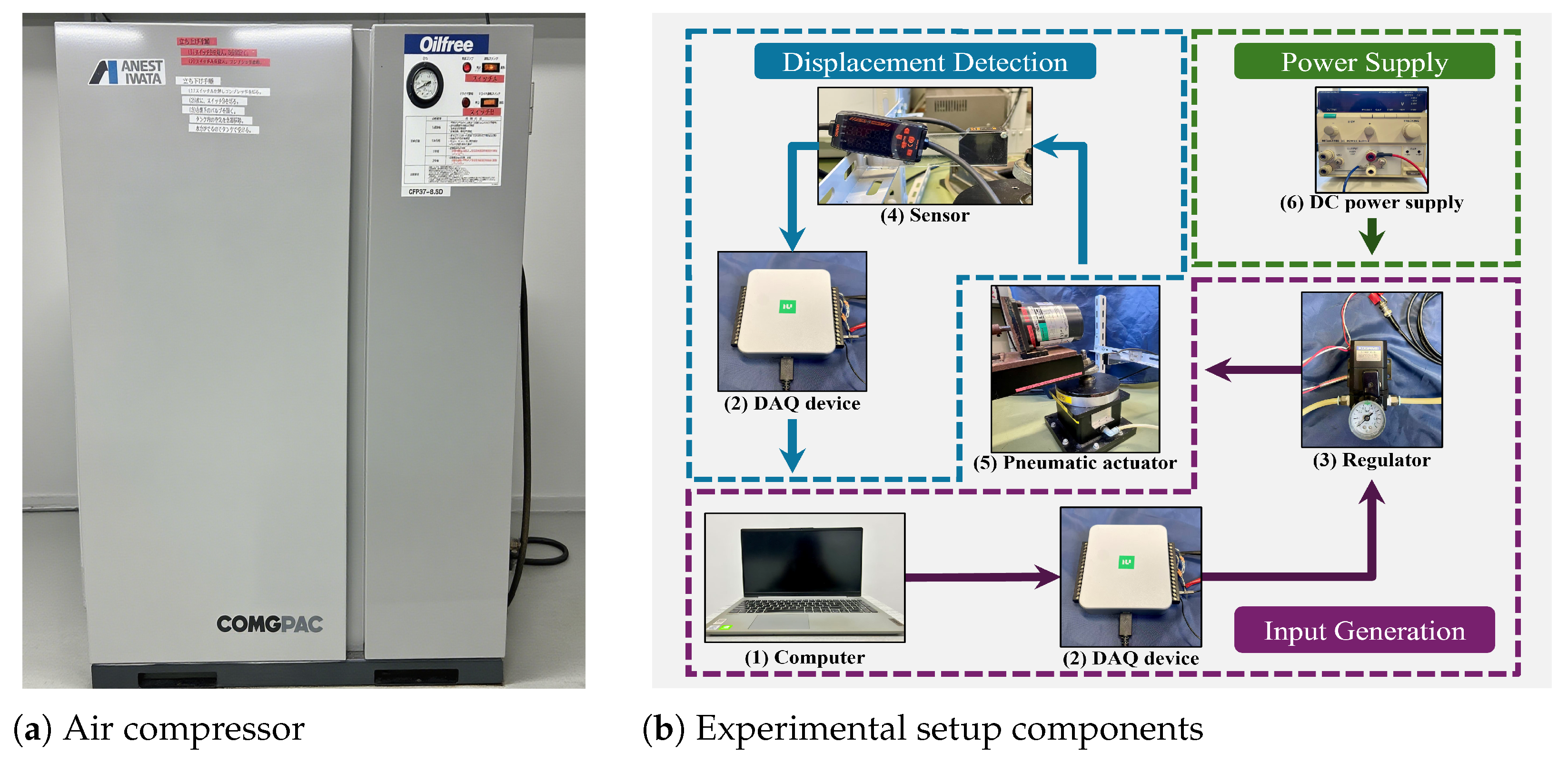



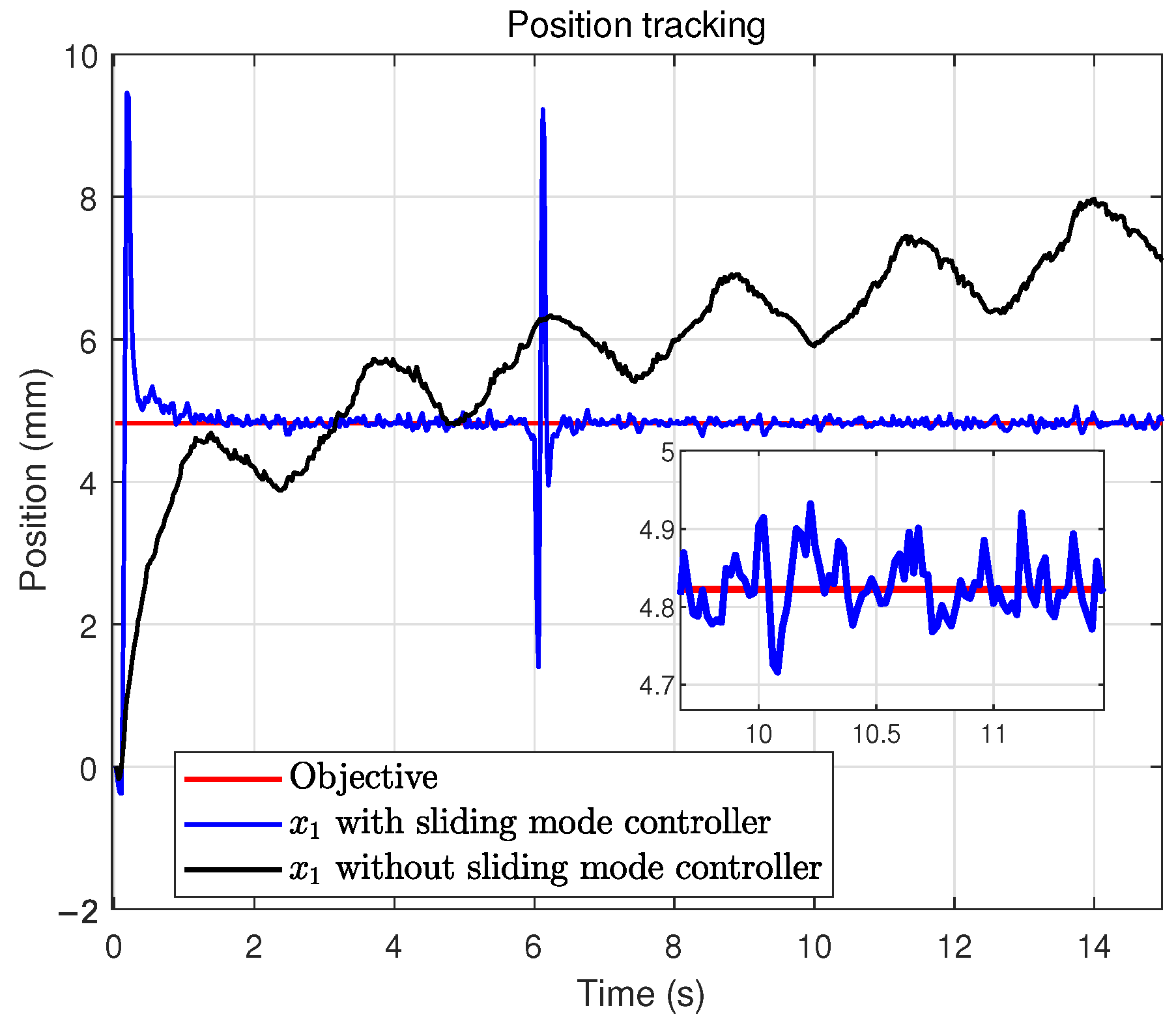


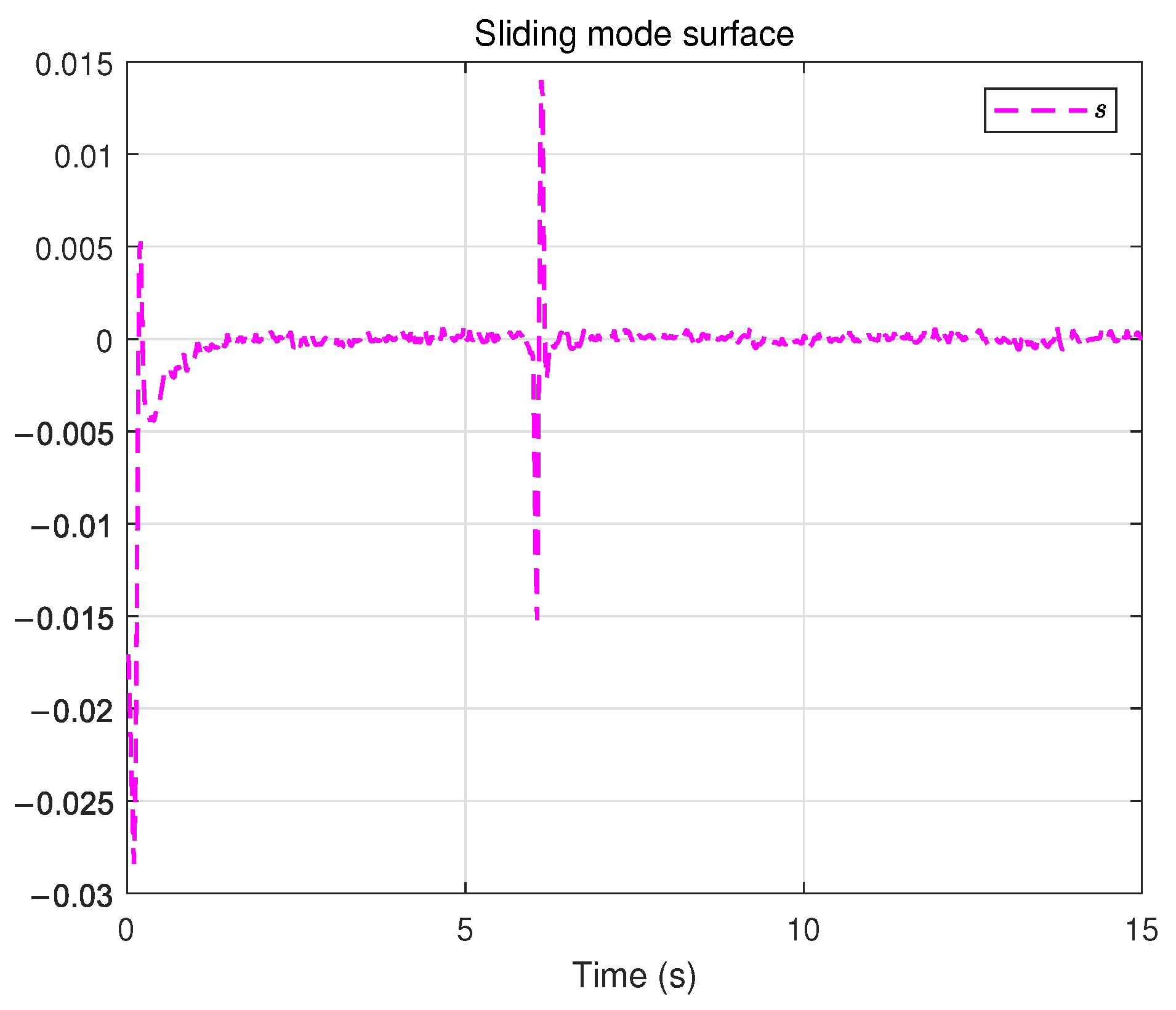


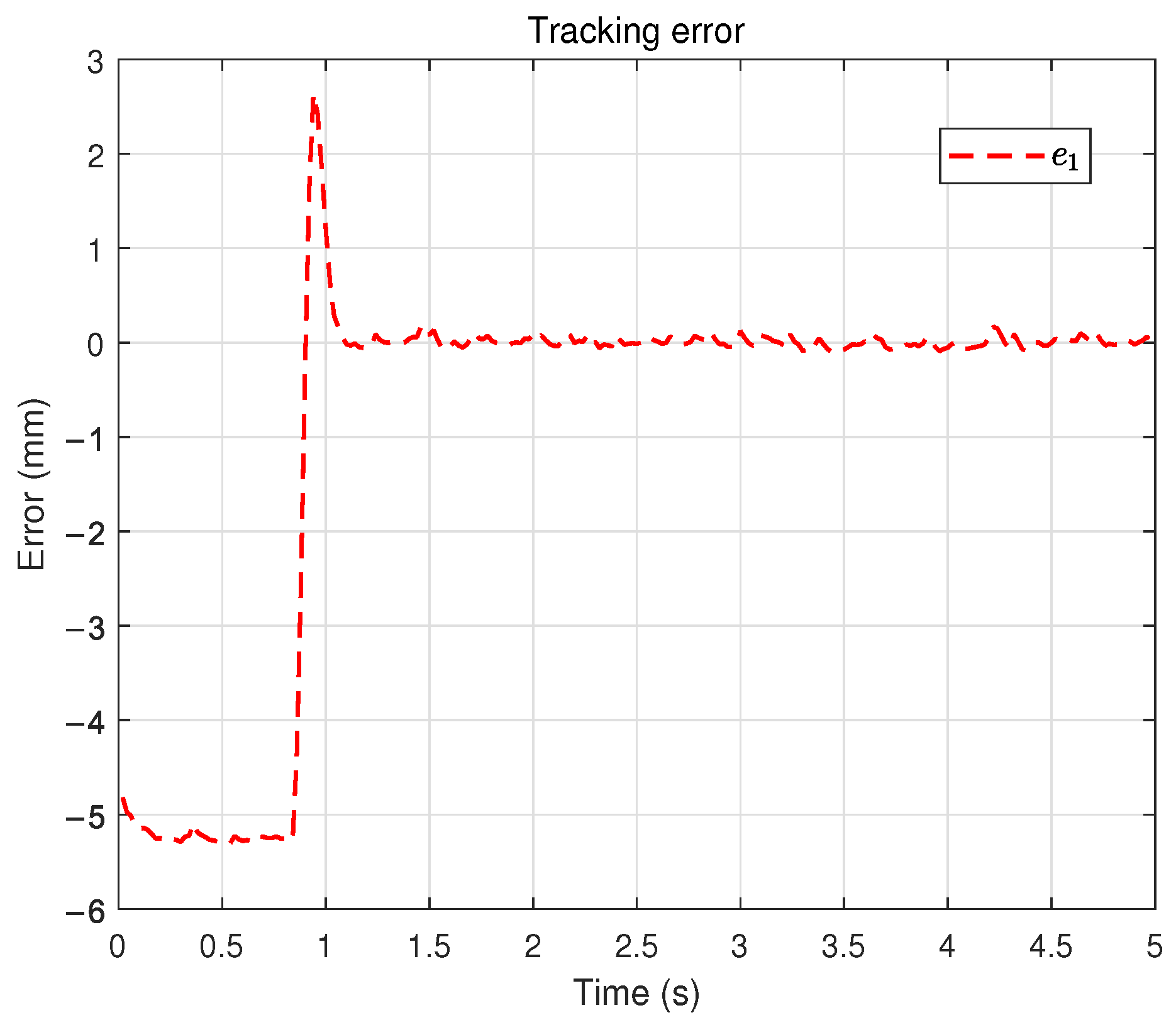
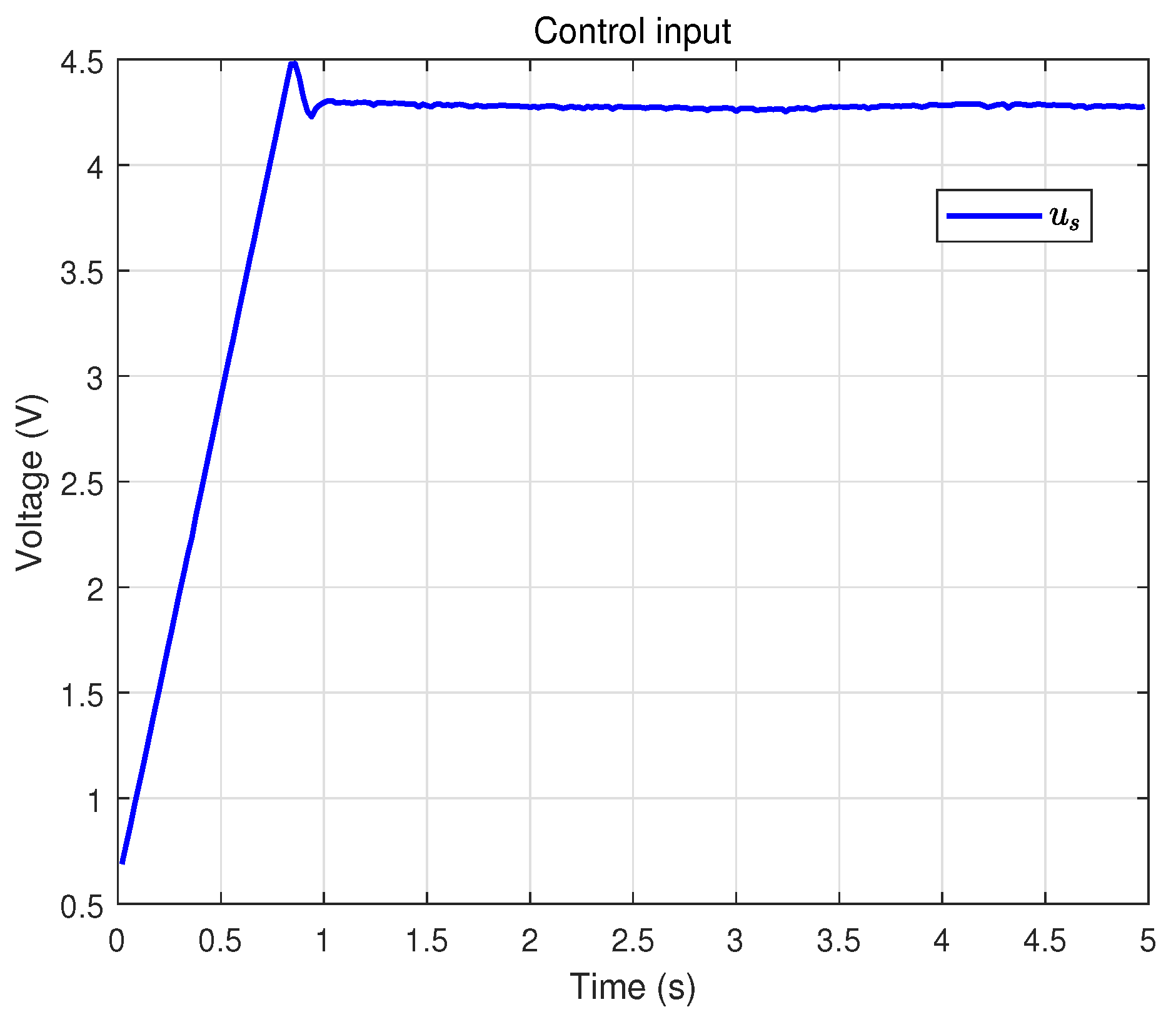


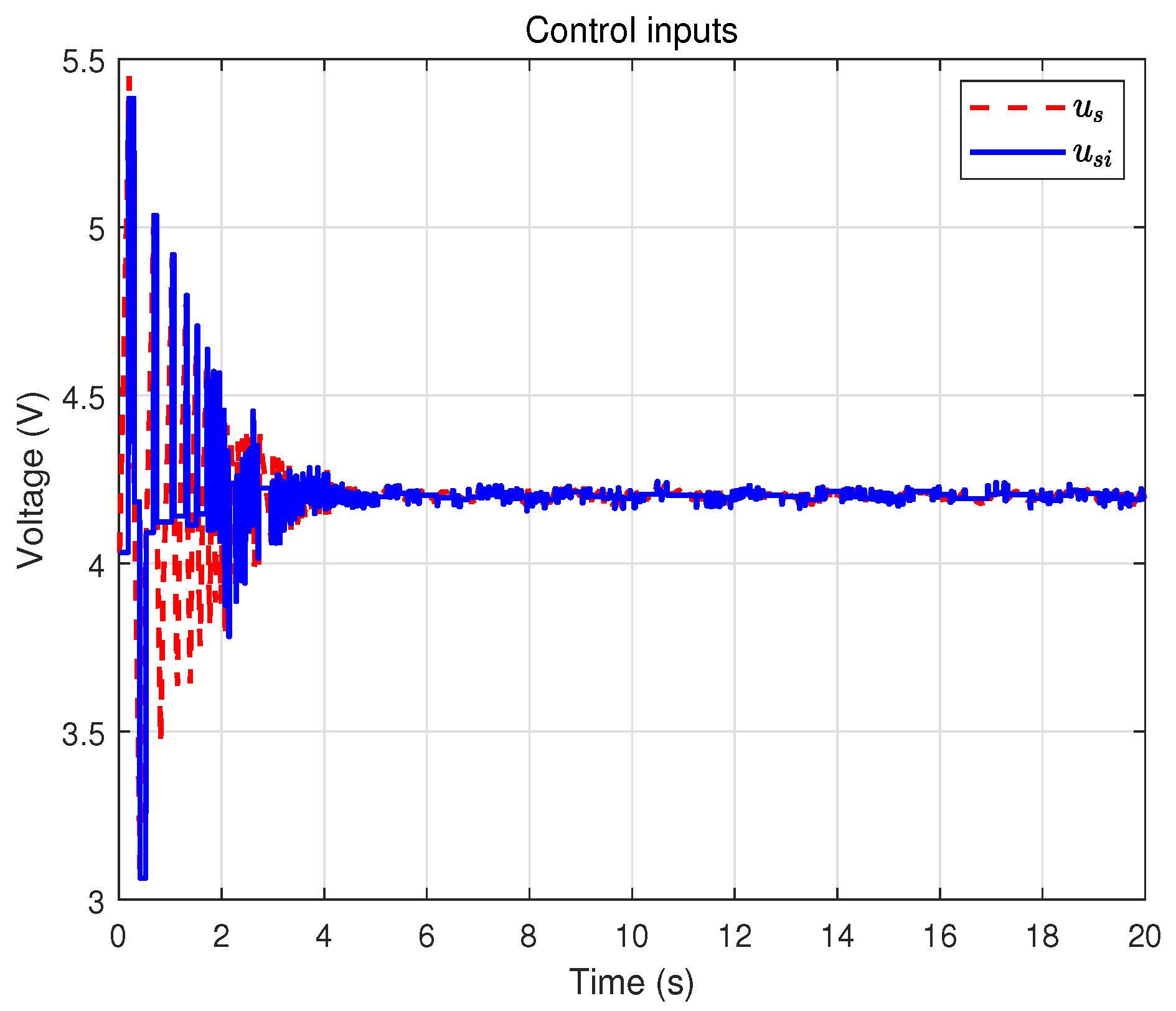

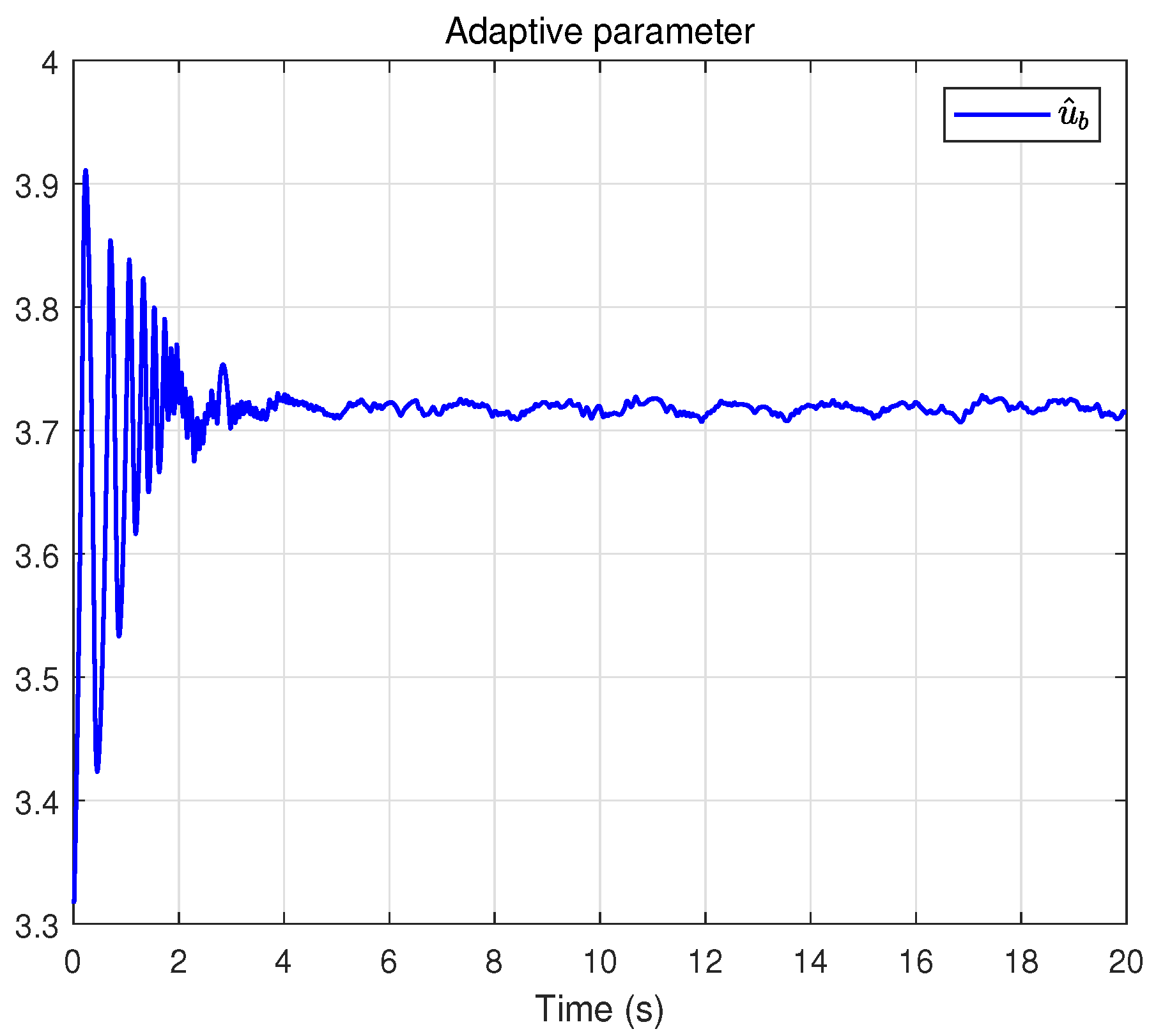
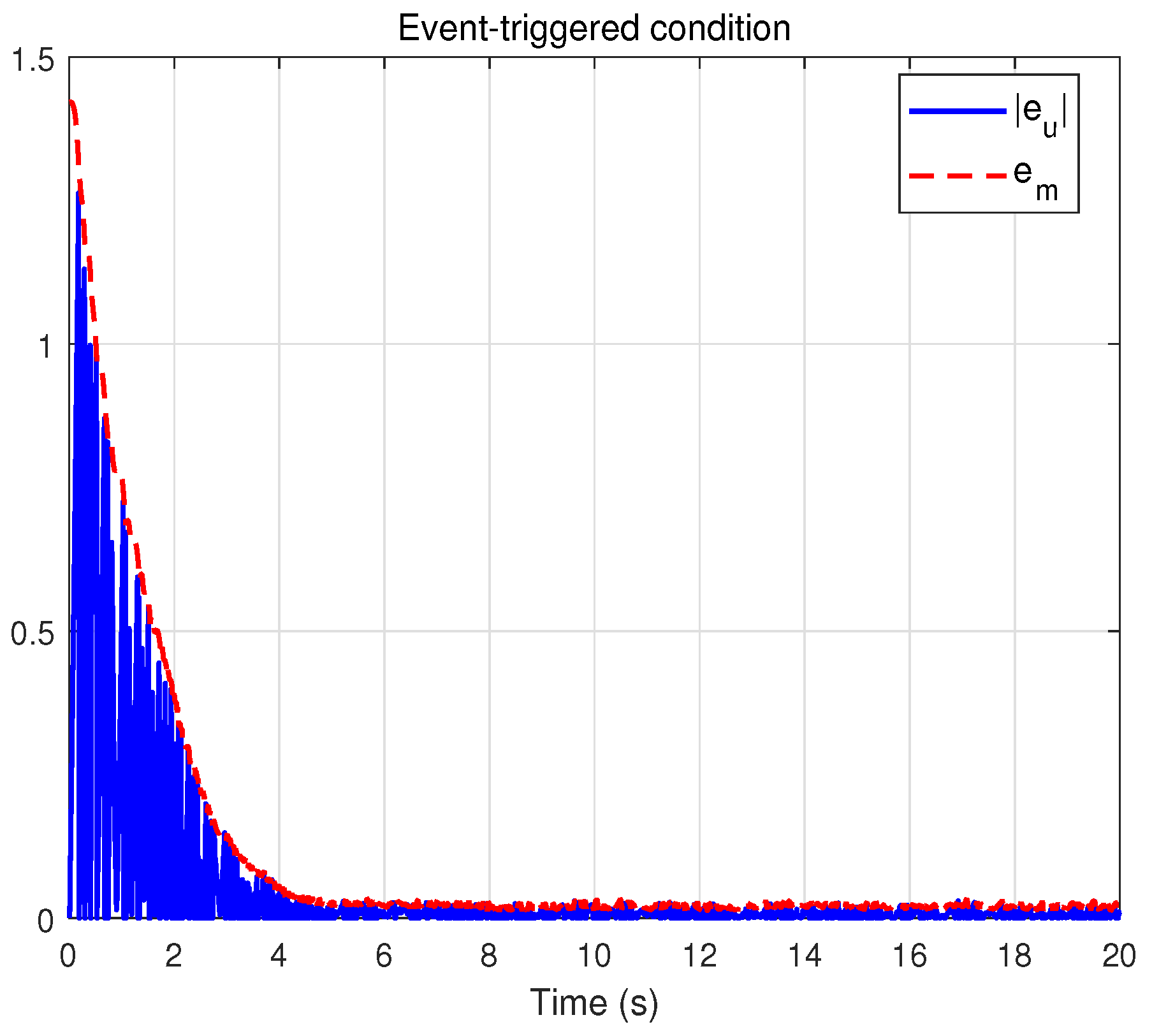
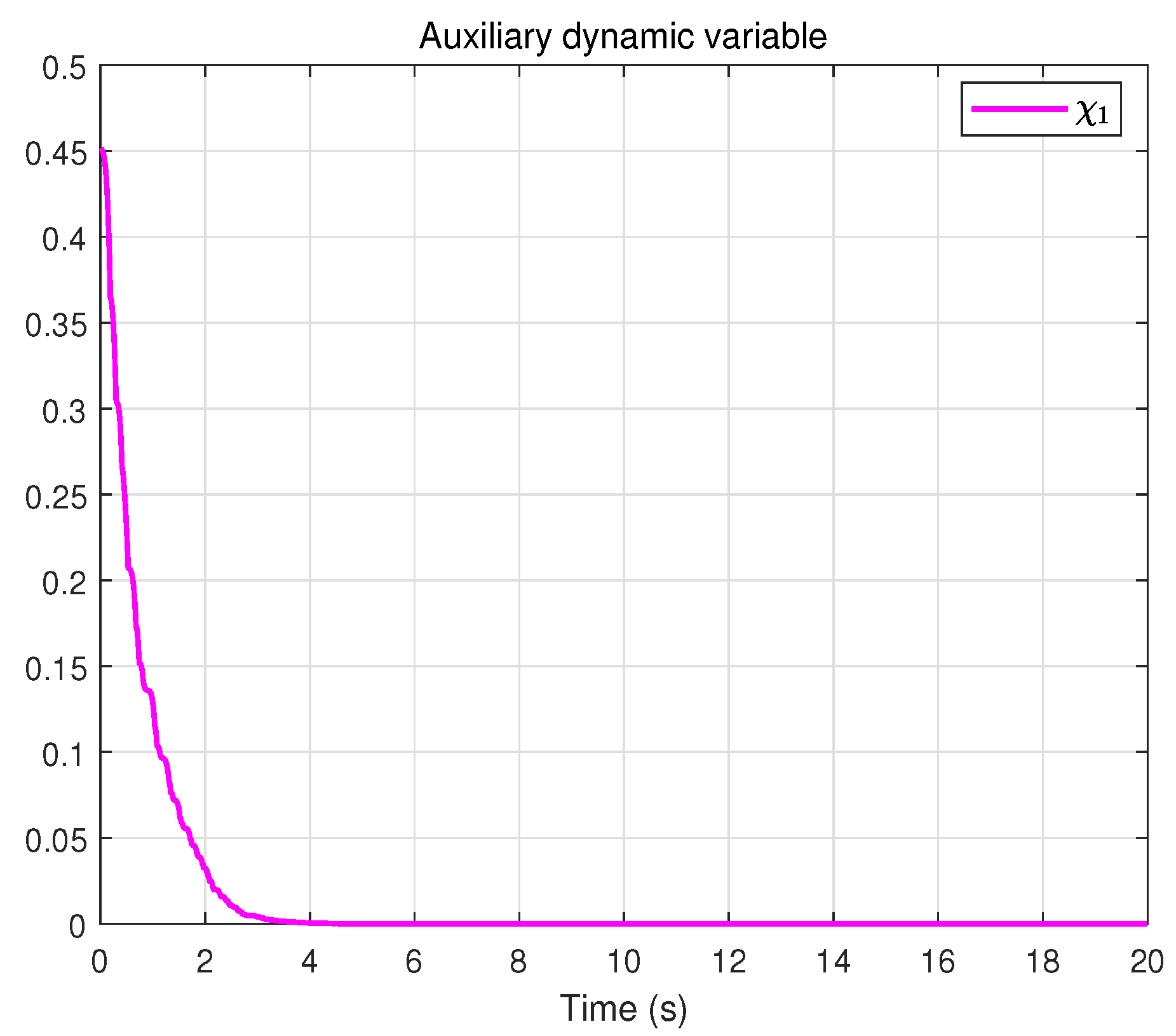

| Component | Specification |
|---|---|
| Air compressor | ANEST IWATA Corporation (Yokohama, Japan); COMGPAC CFP37-8.5D |
| Computer | Lenovo Group Ltd. (Beijing, China); Xiaoxin-15IIL laptop |
| Software | MATLAB R2024b (MathWorks, Natick, MA, USA) |
| DAQ device | NI (National Instruments Corporation), Austin, TX, USA; USB-6002 multifunction DAQ |
| Electro-pneumatic regulator | KOGANEI Corporation (Tokyo, Japan); KTR200-2, input 0–10 V, output 0.02–0.84 MPa |
| Sensor | OMRON Corporation (Kyoto, Japan); ZX-LD40L laser displacement sensor, red laser (650 nm), reference distance 40 mm, measuring range 30–50 mm |
| Power supply | Kikusui Electronics Corporation (Yokohama, Japan); PMM18-2.5DU (±18 V, 2.5 A) |
| Pneumatic actuator | Driving a single-link arm structure as the load |
| Parameters | Values | Parameters | Values |
|---|---|---|---|
| m | 5 | ||
| c | 200 | 3 | |
| k | 25 | ||
| 50 | 2 | ||
| 60 | |||
| 4 | 1 | ||
| 5 |
| Control Scheme | Number of Triggers | Average Trigger Interval | Trigger Rate |
|---|---|---|---|
| Time-Triggered | 2000 | 0.01 s | 100% |
| Static Event-Triggered | 403 | 0.0496 s | 20.15% |
| Dynamic Event-Triggered | 321 | 0.0623 s | 16.05% |
Disclaimer/Publisher’s Note: The statements, opinions and data contained in all publications are solely those of the individual author(s) and contributor(s) and not of MDPI and/or the editor(s). MDPI and/or the editor(s) disclaim responsibility for any injury to people or property resulting from any ideas, methods, instructions or products referred to in the content. |
© 2025 by the authors. Licensee MDPI, Basel, Switzerland. This article is an open access article distributed under the terms and conditions of the Creative Commons Attribution (CC BY) license (https://creativecommons.org/licenses/by/4.0/).
Share and Cite
Zou, H.; An, Z.; Deng, M.; Zhang, G. Adaptive Dynamic Event-Triggered Sliding Mode Tracking Control of Pneumatic Vibration Isolation System. Actuators 2025, 14, 558. https://doi.org/10.3390/act14110558
Zou H, An Z, Deng M, Zhang G. Adaptive Dynamic Event-Triggered Sliding Mode Tracking Control of Pneumatic Vibration Isolation System. Actuators. 2025; 14(11):558. https://doi.org/10.3390/act14110558
Chicago/Turabian StyleZou, Haoming, Zizhen An, Mingcong Deng, and Guoshan Zhang. 2025. "Adaptive Dynamic Event-Triggered Sliding Mode Tracking Control of Pneumatic Vibration Isolation System" Actuators 14, no. 11: 558. https://doi.org/10.3390/act14110558
APA StyleZou, H., An, Z., Deng, M., & Zhang, G. (2025). Adaptive Dynamic Event-Triggered Sliding Mode Tracking Control of Pneumatic Vibration Isolation System. Actuators, 14(11), 558. https://doi.org/10.3390/act14110558







